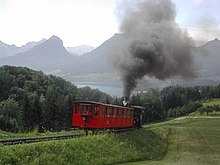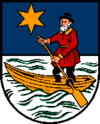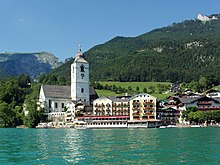St. Wolfgang in the Salzkammergut
|
market community St. Wolfgang in the Salzkammergut
|
||
|---|---|---|
| coat of arms | Austria map | |
|
|
||
| Basic data | ||
| Country: | Austria | |
| State : | Upper Austria | |
| Political District : | Gmunden | |
| License plate : | GM | |
| Main town : | market | |
| Surface: | 56.43 km² | |
| Coordinates : | 47 ° 44 ' N , 13 ° 27' E | |
| Height : | 548 m above sea level A. | |
| Residents : | 2,802 (January 1, 2020) | |
| Population density : | 50 inhabitants per km² | |
| Postal code : | 5360 | |
| Area code : | 06138 | |
| Community code : | 4 07 17 | |
| Address of the municipal administration: |
Markt 28 5360 St. Wolfgang in the Salzkammergut |
|
| Website: | ||
| politics | ||
| Mayor : | Franz Eisl ( ÖVP ) | |
|
Municipal Council : (2015) (25 members) |
||
| Location of St. Wolfgang in the Salzkammergut in the Gmunden district | ||
 Town center |
||
| Source: Municipal data from Statistics Austria | ||

St. Wolfgang im Salzkammergut (also Sankt Wolfgang ) is a market town with 2802 inhabitants (as of January 1, 2020) in Upper Austria in the Gmunden district in the Traunviertel . It is located on Lake Wolfgang in the Salzkammergut and in the judicial district of Bad Ischl .
geography
St. Wolfgang in the Salzkammergut is located at 548 m above sea level in the Traunviertel at the foot of the Schafberg ( cogwheel railway to the 1783 m high peak since 1893 ) on the north bank of the 13.5 km² Aber- or Wolfgangsee lake at 539 m above sea level as a climatic health resort . The extension is from north to south 10.5 km, from west to east 8.1 km. The total area is 56.6 km². 62.4% of the area is forested, 18.0% of the area is used for agriculture. The districts of the municipality are: Aschau, Au, Bürglstein, Graben, Markt, Mönichsreith, Radau, Rußbach, Schwarzenbach, Weinbach, Windhag, Wirling. St. Wolfgang is separated from its neighboring towns on the lake shore by an elevation and a body of water: the 745 m high Bürgl near Strobl and the Dittelbach in the direction of St. Gilgen , which is also the state border between Salzburg and Upper Austria. The village is quite densely built between the hilly landscape and the lake, which gives St. Wolfgang a small-town charm. The town center is bypassed by a 700 m long tunnel under the eastern foothills of the Kalvarienberg.
Community structure
The municipality includes the following 12 localities (population in brackets as of January 1, 2020):
- Aschau (36)
- Au (379)
- Burglstein (1)
- Trench (185)
- Market (574)
- Mönichsreith (95)
- Radau (305)
- Russbach (296)
- Schwarzenbach (203)
- Weinbach (340)
- Windhag (212)
- Wirling (176)
The community consists of the cadastral communities St. Wolfgang and Wolfgangthal.
Neighboring communities
| Steinbach am Attersee | ||
| Sankt Gilgen |

|
Bad Ischl |
| Strobl |
climate
|
Average monthly temperatures and rainfall for St. Wolfgang
|
|||||||||||||||||||||||||||||||||||||||||||||||||||||||||||||||||||||||||||||||||||||||||||||||||||||||||||||||||||||||||||||||||||||||||||||||||||||||||||||||||||||||||
coat of arms
Blazon : Divided by blue and silver; below on green waves a golden barge, standing in it and reaching into the upper field, a boatman with a red coat, black trousers and black hat on his head, with both hands leading a golden oar; top right accompanied by a gold star. Community colors: blue-yellow-green.
The coat of arms was awarded by Emperor Maximilian II in 1567 after the citizens' petitioned the abbot of Mondsee to appeal to the sovereign. In addition to blazon it dismissed as a sign holder on the growing figure of St. Wolfgang in episcopal vestments with hatchet and crosier, which is still used by the community a view. The coat of arms refers to the shipping on the Wolfgangsee, which was of great importance for the residents as well as for the numerous pilgrims. In this context, the star could be understood as “ Stella Maris ”, that is, as a symbol for Mary, the Mother of God.
history
The place owes its name to Saint Wolfgang , who sought refuge in his own monastery Mondsee around 976 as Bishop of Regensburg . The monastery was founded in 748 by Odilo , Duke of Bavaria from the Agilolfinger family . In many legends ( Beilwurf and source wonder at Falkenstein ) the personal construction of the first small church on are Abersee and related miracle cures mentioned.
After Wolfgang's canonization in 1052, numerous miracles and healings contributed significantly to the spread and significance of popular piety and the Wolfgang cult. As the owner of this region, Mondsee Abbey was committed to promoting and disseminating this rite in and around St. Wolfgang. A first Romanesque church was built in 1183 by Pope Lucius III. approved. There are documentary reports of pilgrimages to the little church in Wolfgangland for the year 1291 . From 1314 to 1318 a large pilgrim house was built, which was splendidly expanded in the 15th century, as the many believers from different countries could no longer find enough space in it. Under the abbots Simon Reuchlin , Benedikt Eck and Wolfgang Haberls , who set up the historically important pilgrim fountain in front of the church in 1515, St. Wolfgang experienced brisk building activity.
The house of God gained in importance over the centuries, primarily due to the artistic furnishings. The winged altar by Michael Pacher , completed in 1481 , the baroque altar by Thomas Schwanthaler in 1676 with the relics of Saint Wolfgang as well as the Man of Sorrows and the pulpit by the baroque sculptor Meinrad Guggenbichler in 1706 make the pilgrimage church an extraordinary art object.
The height of the pilgrimages was reached in the 15th and 16th centuries, which was also expressed in artistic creation. After Rome , Aachen and Einsiedeln, St. Wolfgang was the fourth largest pilgrimage site of its time. In 1506, Emperor Maximilian I acquired Mondseeland (the manorial power of the monastery), and in 1567 Emperor Maximilian II granted the place market rights with a coat of arms.
In the course of the Counter Reformation , the pilgrimage was revived again. But the importance of the place of pilgrimage was severely restricted by the reforms of Emperor Joseph II ; In 1791 the Mondsee Monastery was completely dissolved .
The Hupfmühle was first mentioned in the 16th century.
The nearby summer residence in Bad Ischl (1829 to 1916) brought new life and a great upswing for St. Wolfgang . The lake, with its boat trips and the Schafbergbahn, attracted guests from near and far. Famous painters of the 18th and 19th centuries contributed to the international fame of the place and left their mark. On November 8, 1930, the comedy Im White Horse Inn at Lake Wolfgang had its premiere in Berlin . This popular revue piece, which was a worldwide success for St. Wolfgang, attracted great film stars from all over the world to St. Wolfgang. Around 1930 there was even air traffic from Berlin to St. Wolfgang - the landing took place in front of the Grand Hotel by seaplane .
From the earliest times, the Wolfgangland was economically a farming country with an artisanal town center that developed through the pilgrimage around the church, which took on a progressive upswing through the development and development of tourism.
The technical age on Lake Wolfgang began in 1873 with the first paddle steamer, Kaiser Franz Josef .
St. Wolfgang, which has been part of the Austrian Archduchy of Austria ob der Enns since the 16th century , has belonged to the federal state of Upper Austria since 1918. After the annexation of Austria to the German Reich on March 13, 1938, the place belonged to the Gau Oberdonau . After 1945 Upper Austria was restored. In 1951 the parish was renamed from St. Wolfgang to St. Wolfgang in the Salzkammergut .
politics
Mayor is Franz Eisl from the ÖVP .
Population development
In 1991 the community had 2,708 inhabitants according to the census, in 2001 it had 2,797 inhabitants.
Culture and sights
See the list of listed objects in St. Wolfgang in the Salzkammergut
education
- Federal Institute for Adult Education : The Federal Institute for Adult Education moved into the headquarters of the former English-language summer university in the Bürglstein district, right on the municipality border with Strobl , where well-known professors such as the economist Ferdinand A. Westphalen taught. The University of Vienna continues to use the facility for an annual summer college , a four-week international summer program in which "European Studies" from the fields of law, politics, economics, history and art, as well as German courses are offered. Classes are held in English.
tourism
St. Wolfgang and its surrounding area became a well-known tourist area in post-war Austria, but since the 1990s it has lost its importance again. Despite its attractive location in the lake and forested landscape of the Salzkammergut, St. Wolfgang is no longer one of the large tourist communities in Austria. When the Wolfgangsee Tourismus Gesellschaft (WTG) was founded in 1998, the three towns on the lake, St. Gilgen, Strobl and St. Wolfgang, were merged into one marketing unit. However, this could not prevent the negative development of the Wolfgangsee region. In 1990, 1,300,000 overnight stays were counted at Lake Wolfgang, in 2015 there were 885,214 overnight stays according to the annual report of the WTG. Hans Wieser has been managing director of WTG since it was founded.
St. Wolfgang is the end point of the European pilgrimage route Via Nova , which begins in Příbram ( Czech Republic ) and is integrated into the European network of long-distance hiking trails .
The fact that dozens of people in St. Wolfgang were infected with the corona virus in July 2020 can be traced back to tourism employees sleeping in shared rooms and partying in bars after work .
Personalities
Sons and daughters of the church
- Wolfgang Wallner (1884–1964), sculptor, creator of important sculptures in Austria and Germany
- Helmut Peter (* 1948), hotelier and member of the National Council, born in St. Wolfgang
Honorary citizen
- Moritz Sobotka (1843–1918), malt manufacturer
- Hans Nachbauer, Councilor and General Director of the Austrian Transport Office
- Erhard August Scheidt (1865–1929), commercial adviser, industrialist ( Vorwerk )
- Josef Hödlmoser (1858–1948), farmer and politician, Mayor of St. Wolfgang
- Vincent Maximiliaan Baron van Tuyll van Serooskerken (1857-1911), Dutch entrepreneur ( Billiton )
- Manfred Graf Pachta-Rayhofen (1878–1951), district captain of Gmunden 1918–1935
- Josef Rohrmoser (1878–1961), pastor and clergyman, victim of National Socialism
- 1950: Ralph Benatzky (1884–1957), composer of Im Weiße Rößl , buried in St. Wolfgang
- 1972: Robert Stolz (1880–1975), composer and conductor
- 1977: Matthias Hödlmoser (1907–1981), farmer and politician, Mayor of St. Wolfgang
- 1985: Alois Linortner († July 11, 1995), Mayor of St. Wolfgang
- 1997: Josef Windhager (1932–2018), Mayor of St. Wolfgang
- 2002: Helmut Köll, pastor and consistorial councilor (born May 2, 1932)
- 2010: Josef Pühringer , governor
Other personalities
- Johann Maria Boykow (1878–1935), engineer, inventor of the solar compass and automatic aircraft control
- Emil Jannings (1884–1950), actor and first Oscar winner, buried in St. Wolfgang
- Hilde Spiel (1911–1990) came to St. Wolfgang at a young age and from 1955 had her summer residence in her "Haus am Bach"
- Johannes Peinsteiner (* 1961), former mayor of St. Wolfgang and member of the state parliament (ÖVP)
- Rudi Nierlich (1966–1991), ski racer, three times world champion in alpine ski racing, grew up in St. Wolfgang
- Roswitha Raudaschl (* 1967), ski racer
- Bernhard Baier (* 1975), Vice Mayor of Linz
- Andrea Limbacher (* 1989), Austrian freestyle skier
literature
- Peter Pfarl: Reflections on the early history of St. Wolfgang am Abersee . In: Oberösterreichische Heimatblätter 47 (1993) 4, pp. 253-272, online (PDF; 3.2 MB) in the forum OoeGeschichte.at
- Peter Pfarl: “The Wolfgangweg. From Regensburg via Altötting to St. Wolfgang am Wolfgangsee. “Tyrolia, 2013, ISBN 978-3-7022-3257-3 .
Web links
- Market town of St. Wolfgang in the Salzkammergut
- Tourism portal of the Wolfgangsee region
- Further information about the municipality of St. Wolfgang in the Salzkammergut can be found on the geographic information system of the federal state of Upper Austria .
Individual evidence
- ↑ The official spelling is specified or shown in the list of the municipalities of the Upper Austrian provincial government on the Internet and on Statistics Austria: A look at the municipality
- ↑ Statistics Austria: Population on January 1st, 2020 by locality (area status on January 1st, 2020) , ( CSV )
- ^ Province of Upper Austria: coat of arms of the municipality of St. Wolfgang i.Skgt.
- ↑ 42. Announcement of the Upper Austrian state government of October 8, 1951
- ^ Bavaria - Austria - Czech Republic. Association "European Pilgrimage - VIA NOVA", accessed on December 4, 2015 .
- ↑ https://www.fr.de/panorama/corona-st-wolfgang-wolfgangsee-oesterreich-angestelte-infektionswelle-verdienstleistungen-90013351.html
- ↑ Hilde Spiel: Confusion at Wolfgangsee , Leipzig a. a. 1935.







